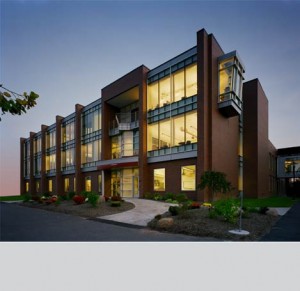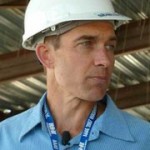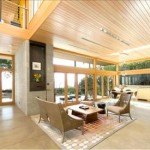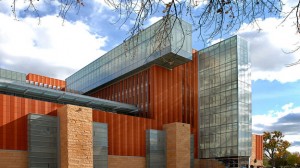RIT Receives Federal Grant to Construct New Sustainability Research Facility
$13.1 million will assist in building Golisano Institute for Sustainability
 Rochester Institute of Technology has been awarded a $13.1 million grant from the National Institute of Standards and Technology to assist in construction of a new green facility that will house the university’s Golisano Institute for Sustainability. The building will serve as a center for sustainability research, technology transfer, education and outreach and provide a state-of-the-art showcase for green construction and design.
Rochester Institute of Technology has been awarded a $13.1 million grant from the National Institute of Standards and Technology to assist in construction of a new green facility that will house the university’s Golisano Institute for Sustainability. The building will serve as a center for sustainability research, technology transfer, education and outreach and provide a state-of-the-art showcase for green construction and design.
“RIT is committed to enhancing sustainable development through innovative research and education initiatives as well as increased implementation of sustainable processes in our facilities and campus design,” notes RIT President Bill Destler. “We are extremely honored to have been chosen for this award, which will assist us in promoting both of these goals and will serve as a model for other universities across the country.”
The Golisano Institute was formed in 2007 thanks to a $10 million gift from Paychex founder and chairman Thomas Golisano, an RIT trustee. The institute currently houses one of the world’s first Ph.D. programs in sustainable production and is developing master’s degrees in sustainable systems and sustainable architecture.
The institute also conducts cutting-edge research in nanotechnology, alternative energy development and validation, sustainable design and pollution prevention and works with a host of businesses and state and federal agencies including Xerox Corp., Eastman Kodak Co., General Motors, Staples, the New York State Department of Environmental Conservation, the U.S. Department of Defense and the U.S. Department of Transportation. The institute also has longstanding relationships with many other companies, assisting in promoting the use of environmentally benign manufacturing, which has reduced waste and energy use while also increasing productivity and efficiency.
“We have focused on projects that reduce the use of hazardous materials in production, expand the quality of remanufacturing processes and alternative energy technologies and develop production systems that are completely closed loop with no waste product,” says Nabil Nasr, assistant provost and director of the Golisano Institute for Sustainability. “This tremendous support from the National Institute of Standards and Technology will assist us in developing new sustainable technologies and processes while also serving as a hub of sustainable development at RIT and in the greater Rochester community.”
The grant is a component of the NIST Construction Grant Program and RIT was selected after an extensive competitive search. Only five projects were selected out of 124 proposals received. RIT has also received $10 million in funding from the state of New York to assist with construction, and New York’s U.S. Senate delegation and Rochester’s congressional delegation have secured substantial funding for the institute’s applied research and technology transfer programs in life-cycle engineering, fuel-cell technology and other focus areas.
In addition, the Golisano Institute has received significant corporate and foundation investments toward its education and research programming as well as its laboratory facilities, including $2 million from Xerox and $1 million from Eastman Kodak.
RIT expects to break ground on the new facility in spring 2011. The new building will be designed to meet Leadership in Energy and Environmental Design standards set by the U.S. Green Building Council, which sets goals for waste and energy minimization and reuse in building construction and operation. The campus already features one LEED Platinum and one LEED Gold facility.
The Golisano Institute for Sustainability builds on over two decades of research and education programming in environmentally benign design, sustainable production and recycling and remanufacturing process improvement conducted at RIT.
“It is imperative that we accelerate strategies to promote a sustainable society and ensure future generations the opportunity to address their own needs,” explains Golisano. “For that reason, it is my desire for the Golisano Institute for Sustainability to produce the first generation of professionals with the vision and know-how to deliver on the promise of sustainability, and I am very proud to be associated with this exciting endeavor.
Santa Barbara Airport Terminal Aims for Green LEED
Boasts State-of-the-Art Features  By Hannah Scott – Laden with Biltmore-style windows, a full service tapas bar, and three glass boarding bridges — at $700,000 a piece — the new
By Hannah Scott – Laden with Biltmore-style windows, a full service tapas bar, and three glass boarding bridges — at $700,000 a piece — the new  Santa Barbara Airport terminal may experience a hard time compelling its travelers to actually leave.
Santa Barbara Airport terminal may experience a hard time compelling its travelers to actually leave.
Opening its doors in April 2011, the two-story, 72,000 square foot terminal will house two Coffee Bean and Tea Leaf cafes, the Costa Terrazo Restaurant and numerous works of art. The Spanish Colonial-style building, constructed by Emma Corporation with a budget of $54 million, is designed to meet the internationally recognized green building standards set by the Leadership in Energy and Environmental Design.
Touring a group of media representatives through the metal structure on Wednesday, September 15, Airport Project Manager Leif Reynolds addressed that the corporation has worked to preserve the charm of the original 1942 terminal. “People say they don’t want it to lose its quaintness,” Reynolds said.
After the completion of the new terminal, the original terminal’s tower and core will be relocated to the new terminal’s southeast corner. The move is scheduled for completion in January of 2012.
As airports are a representation of their community, said Airport Director Karen Ramsdell, the new terminal will host a public art program. Commissioned art includes a mosaic floor medallion, decorative wood beam stenciling, and lengths of ornamental wrought-iron kelp. Once opened, the terminal will also have an organized rotating art exhibit featuring regional artists
Green Building Festival
 On September 22 – 25, 2010, Sustainable Buildings Canada will be hosting the Green Building Festival. The most diverse and impactful green building conference in Canada, GBF has partnered with IIDEX/Neocon Canada – Canada’s National Design Expo & Conference to bring you the best of both worlds; leading edge green building solutions combined with over 400 exhibitors in Canada’s leading design expo. The event is expected to attract over 15,000 visitors. The conference runs from September 22 – 24 and the exposition runs September 23 – 24. It is being held at the Direct Energy Centre in Toronto, Ontario. Since its inception in 2005, the Green Building Festival has continued to grow, inviting industry leaders from around the world to contribute to green building practices in Canada. GBF provides industry professionals with the opportunity to connect with green building thought leaders, explore hundreds of new products and services and get first-hand access to the latest research and business experiences.
On September 22 – 25, 2010, Sustainable Buildings Canada will be hosting the Green Building Festival. The most diverse and impactful green building conference in Canada, GBF has partnered with IIDEX/Neocon Canada – Canada’s National Design Expo & Conference to bring you the best of both worlds; leading edge green building solutions combined with over 400 exhibitors in Canada’s leading design expo. The event is expected to attract over 15,000 visitors. The conference runs from September 22 – 24 and the exposition runs September 23 – 24. It is being held at the Direct Energy Centre in Toronto, Ontario. Since its inception in 2005, the Green Building Festival has continued to grow, inviting industry leaders from around the world to contribute to green building practices in Canada. GBF provides industry professionals with the opportunity to connect with green building thought leaders, explore hundreds of new products and services and get first-hand access to the latest research and business experiences.
Modern clifftop home is both gorgeous and green
 Joanne Ellis’ new clifftop home on Bainbridge Island shows green can also be gorgeous.”It’s pretty darn awesome,” Ellis says in describing her dream home with floor-to-ceiling windows that look east to Seattle. Yet its drama and Puget Sound location is only part of its allure. It’s also energy-efficient. Courtesy of Coates Design
Joanne Ellis’ new clifftop home on Bainbridge Island shows green can also be gorgeous.”It’s pretty darn awesome,” Ellis says in describing her dream home with floor-to-ceiling windows that look east to Seattle. Yet its drama and Puget Sound location is only part of its allure. It’s also energy-efficient. Courtesy of Coates Design
“The whole house is designed to passively cool and heat itself,” Ellis says. It’s oriented to capture sun and shade, and its concrete floors and concrete interior wall hold the heat. On a 100-degree day last year, she says the house was comfortable without air conditioning. Ellis” home — chosen as “This Week’s Green House” — earned the top or platinum rating in June from the private U.S. Green Building Council’s LEED (Leadership in Energy and Environmental Design) program. Her architect Matthew Coates says it’s the first LEED-platinum house in Washington that’s not in Seattle. The 2,450 square-feet home, which has a separate 700 square-foot apartment, spared no expense on its green features, which include geothermal heating, two 1,500 gallon cisterns, a vegetated roof, a 4-kilowatt solar array and Loewen triple-pane wood windows.
Nor did Ellis shortchange design. The home has a sleek but casual look. Its interior has lots of natural light, custom cabinetry and sustainably-harvested Douglas fir ceilings. Its exterior is a blend of concrete masonry units (also used inside), Ipe siding and galvanized metal panels. “We do different variations of Northwest modern. It’s generally a little warmer than typical modern — more wood and Japanese inspiration,” says Justin Helmbrecht of Coates Design, the Bainbridge Island firm that created the Ellis residence. How much did it cost?
Ellis, 60, who moved into the house in January with her husband Ed, 61, says she hasn’t tabulated its total pricetag but says it’s typical of custom building. She says they saved their pennies so they didn’t need a construction loan. “We didn’t want to build just another house,” she says. “We wanted to do something different but didn’t what know. Matthew Coates defined it.” When Coates told them about LEED’s four levels of certification, they were immediately interested. She says her husband, who owns his own shipping business, responded: “Well let’s do platinum!” She says they want to “make a difference” but they’re not political people. “We’ve just lived consciously,” she says. “We’re products of our age — very practical, waste not-want not, a penny saved is a penny earned.” When her three kids (now in their 20s) were little, she says she made her own baby food and used cloth diapers.
They raised their kids on Bainbridge Island, and she says they would stayed in their prior home if they hadn’t seen the cliff top lot for sale. The site had an old cabin and rather than demolish it, they had it deconstructed or taken apart piece by piece so its building materials could be reused and not sent to the landfill. Their new house is tightly sealed (it has mechanical ventilation) and super-insulated (roof is R-60 and walls, R-24) with a mixture of spray-foam and batt insulation. She says their utility bills are now less than those for the condo they rented during construction, and she’ll be getting a refund. “We sell kilowatts to the power company and it sends me a check once a year,” she says.
What she loves about her home, aside from its efficiency and flexible spaces that accommodate visiting adult children, is its magnificent views. “Every window captures a different view,” she says. “I can’t foresee myself ever getting bored with this house.” SOURCE: USAToday
Green Building: A Real Estate Revolution?
by Franklyn Cater – Listen All things Considered
 While much of the U.S. real estate market has been floundering, one area has not seen a dip. Green building now accounts for nearly one-third of new construction in the U.S. That’s up from 2 percent in 2005, according to McGraw-Hill Construction, which tracks the industry. The numbers suggest a revolution is taking place within an industry that is historically slow to change. There are many factors — and many players — in this move toward green building. But one company and its rating system have been undeniably influential in changing construction practice and policy around the country, despite some people’s reservations about whether it’s really helping the environment. University Of Michigan Banks On LEED The new Ross School of business building at the University of Michigan is full of environmentally friendly technology.
While much of the U.S. real estate market has been floundering, one area has not seen a dip. Green building now accounts for nearly one-third of new construction in the U.S. That’s up from 2 percent in 2005, according to McGraw-Hill Construction, which tracks the industry. The numbers suggest a revolution is taking place within an industry that is historically slow to change. There are many factors — and many players — in this move toward green building. But one company and its rating system have been undeniably influential in changing construction practice and policy around the country, despite some people’s reservations about whether it’s really helping the environment. University Of Michigan Banks On LEED The new Ross School of business building at the University of Michigan is full of environmentally friendly technology.
Andy Hoffman, a professor of sustainable enterprise, who teaches a course in green construction, and facilities manager John Bresette gave a tour of the facilities. Oddly enough, among the highlights is a men’s room equipped with dual-flush toilets.
“One of the humorous things about studying this kind of topic is you can talk about dual-flush toilets and waterless urinals in polite company,” Hoffman says. Bresette says it saves a little water to pull the lever up — it uses 0.8 gallons instead of 1.6 gallons if the lever is pressed down. “It’s pretty intuitive,” he says. “I think … the more culturally challenging issue for some people is a waterless urinal. People immediately think, ‘Oh this is gonna stink.’ But it doesn’t smell. You can’t smell it right now.” That’s as long as the filters get changed regularly. In construction, as in other arenas, green manufacturers have sometimes had to contend with the perception that their products are inferior. Plumbers unions have opposed waterless urinals. Nonetheless, the sector for green building products — paint, wallpaper, windows, flooring — is burgeoning.
That sector was practically nonexistent in 1993, when the U.S. Green Building Council got its start. The USGBC created the Leadership in Energy and Environmental Design, or LEED, program. Hoffman gives the council a lot of credit for helping create demand. “They created a cachet around the LEED certification,” he says. “And they got people to want to do this as a marketing pitch — and I think that was really a stroke of genius to get a rather inertial industry to start to shift.” Certified buildings get a plaque for prominent display. And if you already know all of this, it’s a sign of the brand recognition LEED has developed. Hoffman says he thinks this is now key to attracting top students. “College campuses are all starting to go this way,” he says. “If you want to keep up with the Joneses, you kinda gotta do that.”
The University of Michigan leadership agrees. This summer, it committed to seek LEED certification for every new construction project of at least $10 million. On the average $100 million project, the leadership figures it will add 2 percent to the cost. This is a big endorsement of LEED. The university has a $2 billion construction program.
How LEED Works LEED is set up like an arbiter of a sort of building Olympics. Projects earn points for various features. Use renewable cork flooring, for instance, get a point in the materials and resources category. Use paint that doesn’t give off toxic substances — score a point for indoor environmental quality. There are categories for water efficiency and energy. Pay the fees, rack up enough points, and win a basic, silver, gold or platinum rating. The Ross building achieved silver. Andy Hoffman, Holcim professor of sustainable enterprise at the University of Michigan, peers out of a trapdoor in a green roof. Hoffman teaches a course in green construction. The company dumped its bronze rating — and renamed it simply “certified.”
“They’re one of the most savvy nonprofits when it comes to how do you reach out to the press, how to do marketing, and how to communicate their message,” says Michele Russo, director of green research for McGraw-Hill Construction in Washington. “The word LEED meant nothing 10 odd years ago. And now that is literally like Kleenex is to tissues. I mean, you think of a LEED building and people think, ‘Oh, it’s a green building.’ “
Russo says the USGBC has been smart to network with people in every sector. And there’s a growing army of professionals who now have LEED credentials. Around 155,000 designers, contractors, consultants and others have studied up online using courses, then passed the test to earn the designation LEED Accredited Professional — or “green associate.” Employ a LEED AP on a project and you get a point for that. The human infrastructure around LEED far exceeds the number of actual projects. Since 2000, the USGBC says it has registered just a little under 55,000 commercial and residential projects and certified around 12,000. So why are so many people getting credentialed?
As an industry observer, Russo says the LEED AP gives her added credibility. “It is nice to have on the business card,” she says. So many people want the professional designation that it’s a big source of revenue. The USGBC brought in about $107 million last year. Some $42 million of that was related to accreditation. And here’s another reason for professionals to get familiar with LEED: In more and more places, LEED is becoming law. Part 2 of this report will look at how many lawmakers buy the idea that encouraging or forcing developers to build green is not only good for the environment but is also good for economic development, and good for the health of workers who occupy those buildings. But there are those who say LEED doesn’t deliver on all of those promises. NPR’s Franklyn Cater was a 2010 Knight Wallace Journalism Fellow at the University of Michigan, where he studied the intersection of the green economy and the built environment.
Big, Very Green and on Tap for Marin
Anders Swahn plans a massive carbon-neutral home; his neighbors aren’t thrilled By: Zusha Elinson
Anders Swahn stays busy running a solar energy startup. In his spare time he plans his new home, a clean-technology marvel said to be carbon neutral with solar panels, geothermal heating and gray-water recycling. It would be built to last for 200 years and measure up to Marin County’s green building standards. It would also be one of the largest homes in the county, at 15,240 square feet (the average American home is 2,000). That does not include the 2,250-square-foot guesthouse and the 737-square-foot caretaker’s cottage. And it would be constructed on a wooded bluff jutting into San Francisco Bay at the tip of Tiburon. Six years after beginning the approval process, it appears that Swahn, 52, will get the go-ahead from the Marin County Planning Commission in the coming months. But some neighbors remain unconvinced that such a big house can actually be good for the environment. “It will be green, but the truth is that a 15,000-square-foot house isn’t sustainable,” said Sandra Swanson, who lives a few miles down the road. “Trees will be destroyed and think of all the building materials.”
Swahn, an understated Swedish-born engineer who made his millions with semiconductors in Silicon Valley, said in an interview last week that the carbon footprint would be far less than for a smaller, conventionally built house. The naysayers, he continued, are stuck in the old environmental movement. “There’s one part of the movement that lives in the 1960s, dogmatic, fighting the old fight, and there’s the other part that’s living in the current century and is much more practical,” said Swahn, adding that the former group’s position has been: “‘We don’t care how green it is; we don’t like big houses.’” Randy Greenberg, a planning commissioner who opposes the project, said she worried that it would set a precedent for size and be an eyesore when seen from the bay. (Just down the road, a 10,944-square-foot estate, with 11 bedrooms and 10 baths, is on the market for $37 million.) “The population of the world is increasing, and we can’t take so much more than our share,” said Greenberg, who lives nearby. The 15-acre Swahn property will be left wild around the house, which will be hidden by trees, and the house will be clad with local fieldstone, factors that have placated some concerns on the planning commission.
“In return for a big home, it will be a very green home and it will preserve the site forever,” Swahn said. “I think it’s a fair trade-off between the public interest and my private-property rights.” Swahn, who will live in the house with his wife, said he liked the feel of big rooms that open “like meadows.” “It’s just the scale, the volume, the light,” he said. “You know when you go into a public building or a museum how you feel? That is what you get from the size.” And that scale, he added, does not have to hurt the environment: “I think you can have your cake and eat it at the same time.”

